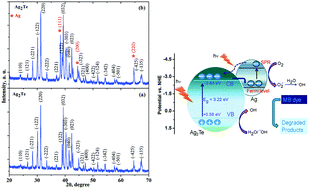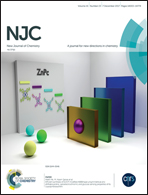Ionic liquid-assisted synthesis of Ag/Ag2Te nanocrystals via a hydrothermal route for enhanced photocatalytic performance†
Abstract
Herein, Ag2Te and Ag/Ag2Te nanocrystals were synthesised via a hydrothermal method using diphenyl ditelluride as a new tellurium source and 1-butyl-3-methyl imidazolium acetate (BMIA IL) as a structure controlling and conducting coating source. The as-synthesized nanocrystals were characterized via XRD, SEM-EDS, XPS, TEM, FTIR, UV-vis, and PL measurements. The photocatalytic behaviour of the Ag2Te and Ag/Ag2Te nanocrystals was investigated for the degradation of methylene blue in the presence of UV-visible light. After 90 minutes of photo-irradiation, up to 95.74% of the dye was photocatalytically degraded by the Ag/Ag2Te nanocrystals. This improved photocatalytic activity was achieved due to the effective charge separation, synergic effect of the Ag2Te semiconductor and plasmonic metallic Ag, conducting BMIA IL coating, and morphological features of the nanocrystals. The appearance of strong peaks in the photoluminescence emission spectra at room temperature suggests a high-level transition in the prepared plasmonic photocatalyst system. The enhanced photocatalytic mechanism for dye degradation using the Ag/Ag2Te nanocrystals has also been described. Thus, the present report presents new insight into the design and development of Ag/Ag2Te plasmonic photocatalysts for environmental applications.



 Please wait while we load your content...
Please wait while we load your content...